Hiring the wrong person can be costly. The cost of bad hires can average around $240,000. This figure might seem shocking, but when you break it down, it includes recruitment, salary, lost productivity, and potential legal fees. A bad hire can drain your resources and strain your team.
Key Takeaways
- Hiring the wrong person can lead to significant financial losses, including recruitment, training, and legal expenses.
- Traditional hiring methods often overlook second-chance employees, who can provide loyalty and motivation.
- The cost of a bad hire varies by job level, with executives having the most significant financial impact.
- Over-reliance on background checks may prevent you from hiring candidates with the true potential for growth.
- Implementing fair chance hiring policies and considering candidates with diverse backgrounds can improve employee retention and workplace morale.
EXPERT INSIGHT: We have all experienced the heavy weight of a bad hiring choice; it reaches far deeper than financial losses, affecting the morale and the faith of the team. I have witnessed the long-term ripple effects that result when the process becomes a frantic rush, based on fears about a prospect's history rather than their future. When we can see candidates as something more than the information on their resumes, the way opens to loyalty, expansion, and a lasting impact. Well-considered second-chance employees frequently have an allegiance rarely found otherwise. The real expense isn't the sole mistake of employing the wrong individual, but rather the loss of the ability to invite the proper individual through a failure to peer deeply enough beneath the surface. - Charm Paz, CHRP
Introduction
What exactly defines a "bad hire"? Typically, it refers to someone who fails to meet job expectations, disrupts team dynamics, or leaves prematurely. The cost of bad hires can be substantial, impacting productivity, morale, and your bottom line. On the flip side, we have "second chance employees." These are individuals with criminal records or employment gaps who often face skepticism in the hiring process. Yet, they can be skilled and dedicated workers eager to prove themselves given the opportunity.
Consider this: many companies overlook second chance candidates due to preconceived notions. Traditional hiring often prioritizes clean records over potential. This approach can be more costly, missing out on loyal and motivated talent just because of past mistakes.
Think about your hiring fears. Do worries of making a mistake overshadow the possibility of hiring a valuable employee with a second chance background? This article will navigate these challenges and explore how embracing second chance hires might be the smarter, more cost-effective choice for your company.
The True Cost of Bad Hires: Breaking Down the Numbers
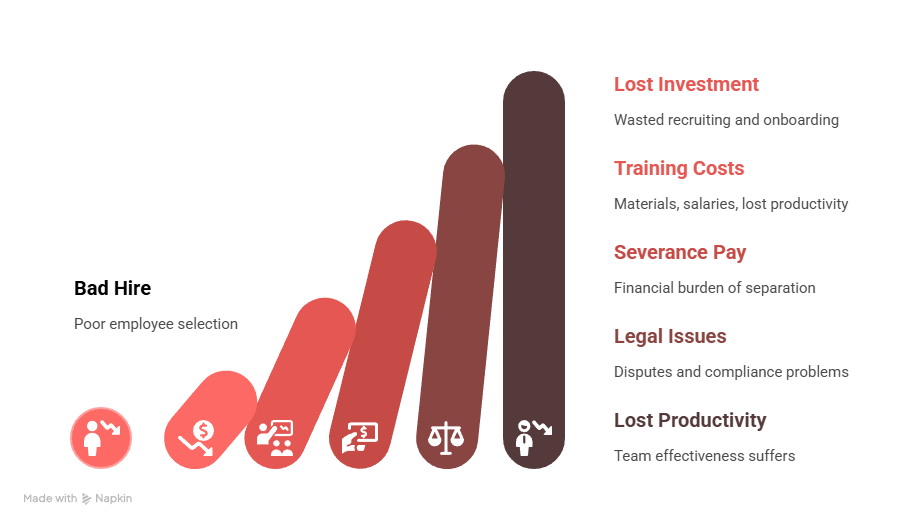
Direct Financial Costs
When it comes to bad hires, the costs add up quickly. Recruitment expenses alone can range between $15,000 to $50,000. These include advertising the job, screening applications, and conducting interviews. Once you choose a candidate, onboarding and training begin. This initial phase is an investment both in time and money.
Imagine training someone, only to lose them shortly after. The financial loss is more than just their salary; it encompasses the resources spent on their integration and upskilling. If they leave prematurely, you essentially find yourself back at square one, facing new expenses for replacing them.
On top of that, there's severance pay if you have to let a bad hire go. You might also deal with legal fees if termination leads to disputes. These additional costs can significantly impact your bottom line.
During the transition period of a bad hire leaving and their replacement stepping in, expect lost productivity. That's more time you and your team will spend adjusting to new workflows. The cycle affects day-to-day operations and can delay achieving strategic goals.
Hidden Costs Most Businesses Miss
Team morale takes a hit when a bad hire disrupts the workplace. This disruption can lower productivity as team dynamics shift. Your clients might notice, too. A mistake by a new team member could damage trust, leading to lost business or strained relationships.
Opportunity costs aren't always apparent. Time spent rectifying hiring errors could have been used to grow your company or develop new projects. Your management team diverts attention from strategic tasks to manage these problems, further draining resources and delaying progress on critical initiatives.
Industry-Specific Cost Variations
The price tag of a bad hire shifts depending on the role. In executive or management roles, you're looking at costs that might exceed $240,000. Mid-level positions typically hit between $50,000 and $100,000. Entry-level roles, while cheaper, still cost between $15,000 and $25,000. The higher the position, the greater the financial impact, considering their influence and responsibilities.
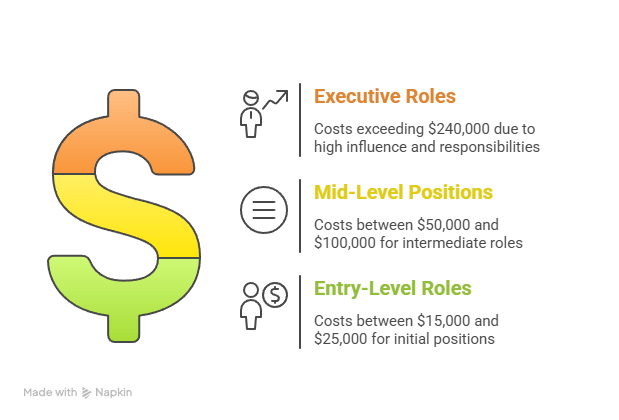
Each bad hire impacts your bottom line in multifaceted ways. Next time you're hiring, consider the full range of potential costs. Are you truly prepared for them? Could your approach to hiring benefit from a change to mitigate these risks?
Why Traditional Hiring Creates More Bad Hires
Traditional hiring practices often fall short. They focus on finding the "perfect candidate," ignoring the nuances that make a good fit. Overemphasizing backgrounds over practical skills can lead you to miss out on qualified individuals who may not have spotless histories. Instead, what makes a candidate truly valuable? Look beyond the resume.
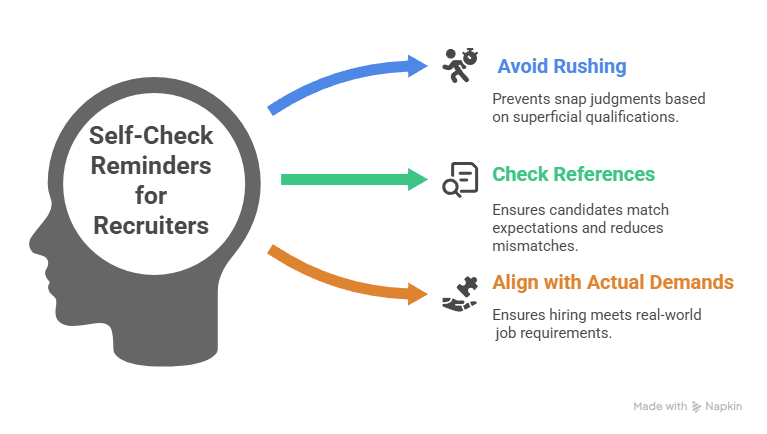
Background checks, while essential, can create a false sense of security. A clean record doesn't guarantee job performance. Performance often hinges more on skills and cultural fit than what a background check reveals. Many companies trust background checks to weed out risks, but this reliance can blindside them when a candidate's real-world abilities fall short.
- Are you rushing hiring decisions? Oftentimes, the pressure to fill a position quickly can lead to snap judgments based on superficial qualifications. This is where confirmation bias sneaks in, clouding your judgment as you look for traits that affirm your preconceptions. A hasty decision today can lead to more significant headaches tomorrow.
- Have you fully checked candidates' references? Many times, reference checks get skipped or rushed. This oversight can result in unexpected mismatches between the job and the hired talent. It's crucial to dig deeper—not only to confirm qualifications but to understand how candidates have handled real challenges in past roles.
- Are you hiring for a position's actual demands or based on an idealized candidate profile? Real-world requirements often diverge from job postings. Bridging this gap can prevent hiring mishaps and align your expectations with on-the-ground realities.
Rethink how you evaluate candidates. Soft skills and alignment with company culture often carry more weight than a perfect track record. Avoid viewing candidates as mere backgrounds; instead, consider their potential contributions and fit within your team. Adapting your approach can reduce bad hires and enhance your workplace with truly competent individuals.
The Second Chance Employee Advantage
Second chance employees—those with criminal backgrounds, employment gaps, or career changes—can often be overlooked by employers. Yet they offer significant value that traditional candidates might not. Embracing this pool of untapped talent can lead to real advantages for your company.
Hiring someone with a criminal background doesn't mean accepting higher risks. Many programs support the rehabilitation and employment of ex-offenders, offering them a fresh start. Consider the statistics: second chance employees often exhibit a 13% higher retention rate. This suggests a level of loyalty that can be invaluable for businesses focused on lowering turnover and enhancing team stability.
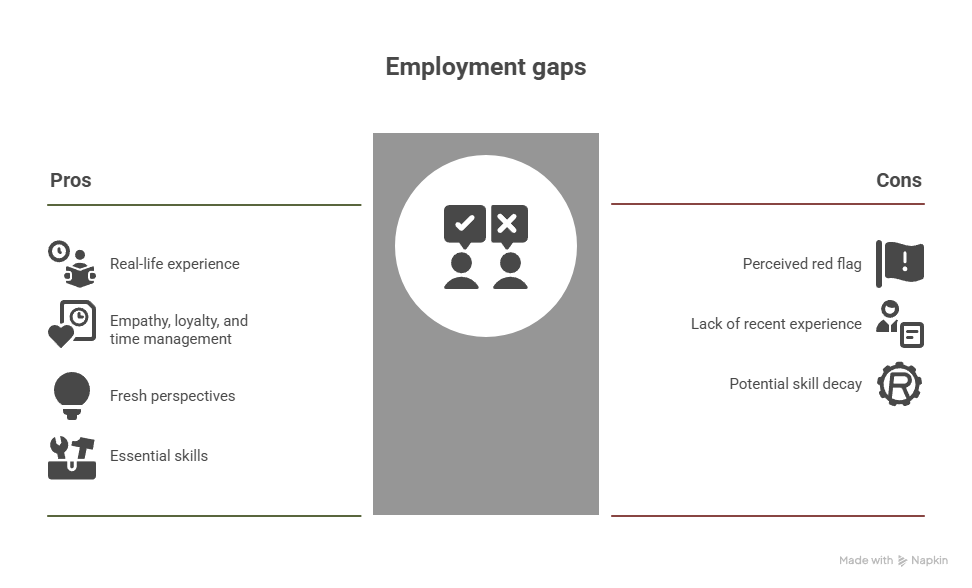
Employment gaps, often viewed as red flags, can reveal candidates who have gained real-life experience. Someone who took time off to care for a family member might bring a level of empathy and time-management skills unmatched by candidates with uninterrupted work histories. Similarly, career changers may possess essential skills from previous roles, allowing for fresh perspectives and innovative problem-solving.
Incorporating second chance employees into your hiring strategy involves more than just goodwill—it's about creating a sustainable and motivated workforce. Do your current hiring practices allow for this type of inclusion? And how thoroughly do you evaluate the potential of a second chance candidate?
Smart background check strategies can help. Focus on relevance and recency rather than past mistakes. Recognize rehabilitation efforts and personal growth as part of the equation. Balance perceived risks with the opportunity to nurture dedicated employees who can potentially outperform those with spotless records.
You'll not only help an individual rebuild their life, but you’ll also enrich your company with committed and often exceptionally motivated employees. Is your company ready to harness the power of second chance hiring? The benefits may be just what your team needs.
Case Studies: Real Business Impact
Some companies rethink how they use background checks. Instead of a barrier, they use them as a tool for understanding candidate history. The outcome was not only a more diverse workforce but one that deeply appreciated their second chance, translating into higher dedication and retention rates.
| Company | Challenge | Approach | Results | Key Lesson |
|---|---|---|---|---|
| Manufacturing Company | Sky-high turnover rates hurting bottom line | Second chance hiring - partnering with local organizations to recruit individuals with criminal records | Turnover dropped by 40% within a year, employees showed remarkable loyalty, saved on recruitment/training costs, boosted productivity | Marginalized workers can be highly diligent and loyal, creating stable workforce |
| Tech Firm | High-profile hire that backfired | Traditional hiring approach based on stellar academic background and impressive work history | Candidate clashed with team, missed deadlines, blamed others, morale plummeted, projects delayed, costly departure | Traditional resume-based approaches fail to predict real-world performance and cultural fit |
Background checks, when used effectively, can act as a powerful tool in hiring decisions. They should inform rather than outright eliminate candidates. This starts with understanding the specific needs of the role you're hiring for and tailoring the background check to that role. Not all positions require the same level and type of scrutiny.
Additionally, when a red flag appears, don't jump to conclusions. Initiate a conversation with the candidate. Discuss any discrepancies or concerns noted in the check. This practice not only gives fair chance for explanation but reinforces transparency and builds trust.
By using background checks strategically, you not only protect your company but also open doors to diverse talent you might otherwise overlook.
For Business Owners: Rethinking Your Hiring Strategy
Creating an effective hiring strategy starts with fair chance policies. These policies advocate for giving candidates with diverse backgrounds an equal shot at employment. Consider defining clear guidelines that emphasize skill and potential rather than focusing solely on past indiscretions.
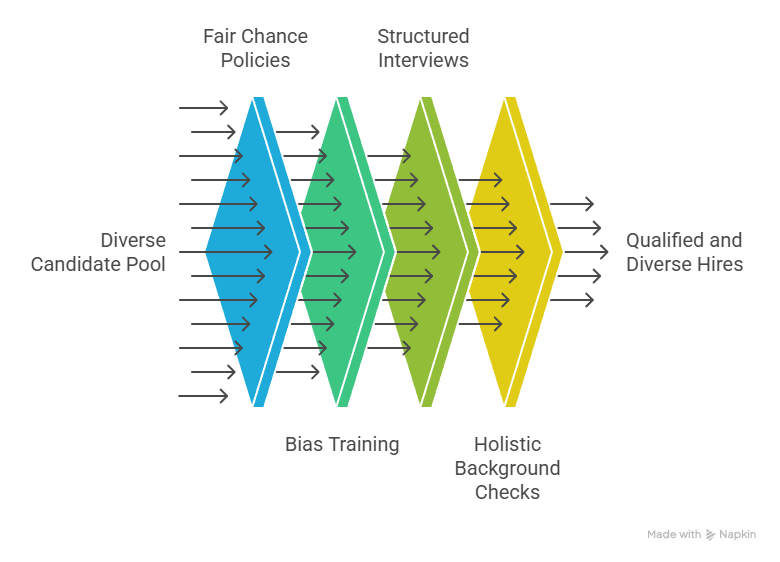
Bias training for hiring managers is crucial. All too often, unconscious biases influence hiring decisions. Equip your team with the tools to recognize and counter these biases. This helps ensure candidates are judged on their qualifications and potential.
Structured interviews provide consistency. They help mitigate bias by focusing on a candidate’s skills and experiences rather than subjective impressions. Develop a set of questions aligned with your company’s values and the specific job requirements.
Holistic background checks should be part of the process, but they are not the whole story. Use them to inform your understanding of a candidate, not to disqualify them outright. Consider the relevance and recency of any flags, and place them in the context of a candidate's overall application.
For Job Seekers: Positioning Your Background Positively
If you have a history that concerns potential employers, address it proactively.
- Be honest about your past, but focus on what you’ve learned and how you’ve changed. Demonstrating growth can turn a potential red flag into a strength.
- Showcase reliability and growth with real examples. Highlight any continuous employment, new skills you’ve acquired, and positive references that reflect your growth. Balance the past with a clear display of your current competencies.
- Understanding the background check process can be empowering. Know your rights, such as requesting copies of the report and correcting any inaccuracies. This knowledge can help you navigate the process more confidently.
By shifting focus from past issues to present qualifications and future potentials, you transform the narrative. You are not merely a candidate with a history; you’re a living testament to growth and determination.
The ROI of Smarter Hiring Decisions
Conducting a cost-benefit analysis when hiring can reveal surprising insights. Weigh the initial savings of avoiding a second chance candidate against the potential long-term gains they might bring. Factors like improved retention rates and diverse perspectives can shift the balance.
Smarter hiring is about more than avoiding mistakes. It's about maximizing opportunity. Consider success metrics beyond bad hire avoidance, like team morale, engagement, and innovation. These can all be enhanced with a broader hiring scope that includes second chance candidates.
The Bottom Line
Hiring decisions directly affect your company's bottom line. Bad hires drain resources, dampen team spirit, and can sour client relations. On the flip side, second chance employees often defy low expectations by proving reliable, loyal, and eager to contribute.
Balancing background checks with a keen eye for skills and potential can reshape your talent pool. Incorporate comprehensive background checks as a tool to inform, not automatically eliminate potential hires. This approach broadens your pipeline, introducing candidates who may bring unique insights and dedication.
Thinking beyond conventional methods opens doors. Consider the cost savings and enhanced workplace culture when second chance hiring is on the agenda. It’s not just about sidestepping bad hires—it's about recognizing the promise in overlooked talent.
Revisiting your hiring strategy to include second chance employees can redefine success. The benefits extend beyond financial metrics, enhancing your workplace with diversity and inclusivity. This may be the opportunity to build a workforce that thrives on diverse experiences and backgrounds. Embrace the chance to lead with a more inclusive vision, championing growth for both individuals and your company.
Frequently Asked Questions
What is the cost of a bad employee?
Bad employees can cost your company substantial resources in lost productivity, increased errors, and disrupted team dynamics. Studies suggest that a single bad hire can cost a company an average of $17,000.
What is the highest cost attributed to wrong hires?
The highest cost is often related to lost productivity and damaged team morale, which can affect overall company performance. The impact can also extend to increased overtime costs for coworkers compensating for the underperforming employee.
What is the cost per hire?
The average cost per hire can range from $4,000 to $7,000, depending on the industry and role. This includes expenses such as job advertising, recruitment agency fees, and the time spent by internal staff on interviews.
What is the cost of losing good employees?
Losing a good employee can have costs that include recruitment, training of new hires, and potential productivity loss. This can be approximately 1.5 to 2 times the salary of the departing employe.
What is the cost of a toxic workplace?
A toxic workplace can lead to significant turnover, reduced employee engagement, and increased absenteeism. It can cost businesses millions in lost productivity and the expenses related to rehiring and retraining.
What are the effects of bad employees?
Bad employees can lower team morale, decrease productivity, and create a negative work environment. They may also increase turnover as other employees become dissatisfied.
What is the true cost of a bad boss?
A bad boss can lead to skyrocketing turnover rates, decreased employee engagement, and diminished team performance. It can cost the organization in terms of lost productivity and the need to replace valuable staff.
What is the cost value of an employee?
The cost value of an employee includes salary, benefits, training, and any other compensation-related expenses. This varies by role and industry but is essential for understanding the return on investment for each employee.
What is an acceptable labor cost?
Acceptable labor costs vary by industry but usually range from 20% to 35% of gross sales. Understanding your industry standards can help you monitor and control these costs effectively.
What defines a bad employee?
A bad employee often shows consistent poor performance, a lack of teamwork, and negative behavior that can affect others. They'll often fail to meet job responsibilities and may be unwilling to improve despite feedback.
How can you improve employee retention?
Offer competitive salaries, foster open communication, and provide professional development opportunities. Recognizing and rewarding achievements also helps build a positive culture.
What steps can you take to remediate bad employees?
Provide clear feedback, set expectations, and offer training or mentorship. Sometimes, a reassessment of their role or responsibilities may be necessary to better align with their skills.
How can you create a positive workplace culture?
Encourage open communication, inclusivity, and teamwork. Celebrating successes and providing support during challenges helps maintain a positive environment.
What are the benefits of investing in employee development?
Investing in development increases employee satisfaction, improves skill sets, and boosts productivity. It often leads to higher retention rates and a better-skilled workforce.
Additional Resources
- Main cost of bad hires study:
https://humcapinc.com/cost-of-bad-hires-blog/ - Additional cost breakdowns:
https://breezy.hr/blog/cost-of-bad-hire
https://www.business.com/articles/cost-of-a-bad-hire
https://apollotechnical.com/cost-of-a-bad-hire/ - Turnover and hiring best practices:
https://vendordirectory.shrm.org/company/930082/news/3518467/the-cost-of-a-bad-hire
Still have questions?
Get in touch with our team today for a personalized demo and discover how our tailored volume pricing and packages can drive results for your business!
How useful was this page?*
Note: your comments are anonymous. We use them to improve the website. Do not include any personal details.
Visit our FCRA Compliance Tool or leave a message here if you need a response.
From the blog Explore the GCheck Content Hub

Employment Verification Compliance 2026: Strategic Guide for Modern HR Teams
29 Dec, 2025 • 17 min read
What Shows Up on an Employment Background Check in 2026: A Complete Compliance Guide
29 Dec, 2025 • 20 min read
How to Run a FACIS Background Check: Complete Guide for Healthcare Compliance
18 Dec, 2025 • 20 min readThe information provided in this article is for general informational and educational purposes only and should not be construed as legal advice or a substitute for consultation with qualified legal counsel. While we strive to ensure accuracy, employment screening laws and regulations—including but not limited to the Fair Credit Reporting Act (FCRA), Equal Employment Opportunity Commission (EEOC) guidelines, state and local ban-the-box laws, industry-specific requirements, and other applicable federal, state, and local statutes—are subject to frequent changes, varying interpretations, and jurisdiction-specific applications that may affect their implementation in your organization. Employers and screening decision-makers are solely responsible for ensuring their background check policies, procedures, and practices comply with all applicable laws and regulations relevant to their specific industry, location, and circumstances. We strongly recommend consulting with qualified employment law attorneys and compliance professionals before making hiring, tenant screening, or other decisions based on background check information.


